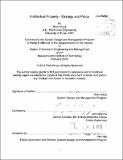| dc.contributor.advisor | Joe Hadzima. | en_US |
| dc.contributor.author | Ahuja, Rishi | en_US |
| dc.contributor.other | System Design and Management Program. | en_US |
| dc.date.accessioned | 2013-02-14T15:18:00Z | |
| dc.date.available | 2013-02-14T15:18:00Z | |
| dc.date.copyright | 2012 | en_US |
| dc.date.issued | 2012 | en_US |
| dc.identifier.uri | http://hdl.handle.net/1721.1/76923 | |
| dc.description | Thesis (S.M. in Engineering and Management)--Massachusetts Institute of Technology, Engineering Systems Division, System Design and Management Program, 2012. | en_US |
| dc.description | Cataloged from PDF version of thesis. | en_US |
| dc.description | Includes bibliographical references (p. 70-73). | en_US |
| dc.description.abstract | The thesis that follows is an attempt to gain a deeper understanding of intellectual property from a policy as well as a strategic perspective. While the discussion that follows is applicable to intellectual property in general, the focus of this thesis is on a particular aspect of intellectual property i.e patents. Policy and strategic perspectives are covered in section I and 11 respectively. The section on policy explores the origin and evolution of intellectual property related policies by discussing key legislation and court cases. The two questions that were most relevant when exploring the policy side of the patent system were: -- Is the intellectual property system hindering or encouraging innovation? -- What changes, if any, are required to make the system more effective? The section on strategy looks at IP strategies (or lack thereof) of three leading companies, Apple, Google and Microsoft. These three companies were selected because of their apparently differing strategies and this cursory judgement was confirmed when the strategies of the companies were put under a microscope. The question that were central while exploring the strategic aspects of intellectual property were: -- How are these three companies coping with the patent system as it exists today? -- What changes can make the strategies employed more effective? The summary section at the end tries to reconcile these two different ways of looking at the intellectual property system into a coherent whole. | en_US |
| dc.description.statementofresponsibility | by Rishi Ahuja. | en_US |
| dc.format.extent | 73 p. | en_US |
| dc.language.iso | eng | en_US |
| dc.publisher | Massachusetts Institute of Technology | en_US |
| dc.rights | M.I.T. theses are protected by
copyright. They may be viewed from this source for any purpose, but
reproduction or distribution in any format is prohibited without written
permission. See provided URL for inquiries about permission. | en_US |
| dc.rights.uri | http://dspace.mit.edu/handle/1721.1/7582 | en_US |
| dc.subject | Engineering Systems Division. | en_US |
| dc.subject | System Design and Management Program. | en_US |
| dc.title | Intellectual property : strategy and policy | en_US |
| dc.type | Thesis | en_US |
| dc.description.degree | S.M.in Engineering and Management | en_US |
| dc.contributor.department | System Design and Management Program. | en_US |
| dc.contributor.department | Massachusetts Institute of Technology. Engineering Systems Division | |
| dc.identifier.oclc | 824176729 | en_US |
